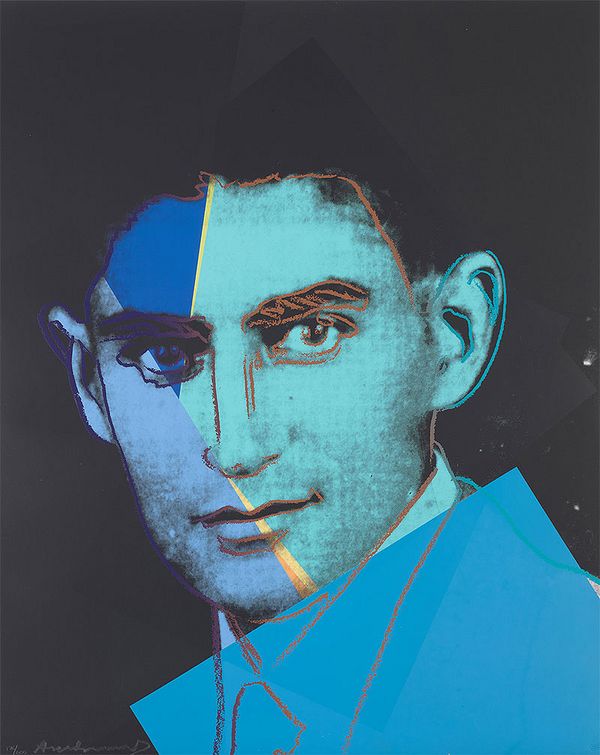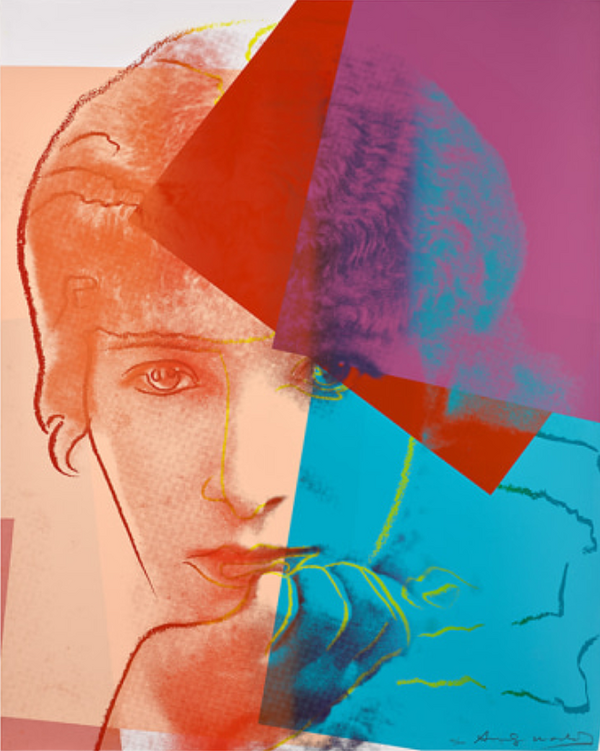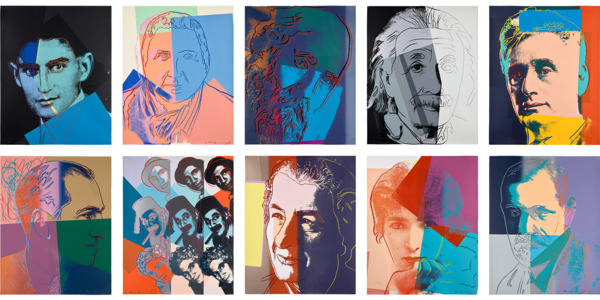Andy Warhol, Ten Portraits of Jews of the Twentieth Century (F. & S. 226-235), 1980. Editions & Works on Paper, New York.
Written by Matthew F. Singer
There are portraits in paint and portraits in words. Without semi-specialized Warholian knowledge, an American Jew of a certain age, like myself, could be forgiven for scanning the words “Ten Portraits of Jews of the Twentieth Century” and thinking it the title of a vaguely recalled Hebrew school primer published in the mid-twentieth century to promote ethnoreligious pride. I was born in 1963, the year Warhol made his first of hundreds of commissioned portraits, Ethel Scull Thirty-Six Times. In the context of discussing Andy Warhol’s Ten Portraits of Jews of the Twentieth Century, it cannot go unnoted that Mrs. Scull and her husband, Robert, were Jewish, leading early collectors of Pop Art — and often dismissed as arrivistes buying into society by acquiring art. The Sculls can, for the sake of this consideration, also be conceived as stand-ins for the parents and grandparents of people like me and my fellow Jewish Baby Boomers and early Gen Xers. We came of age in the 1960s, ‘70s, and ‘80s, when American Jewry was still struggling with how (for some, whether) to discuss the Holocaust, stunned and stirred by the establishment of Israel in 1948, and ambiently anxious over the series of wars that followed that founding.
There was something else about us and our families. Most of my Jewish American contemporaries were grandchildren or great-grandchildren of Eastern European Jews who arrived in the US circa 1900, others were first-generation Americans born to parents who fled or survived the Shoah. There was to our parents and us a faded but not fully shed whiff of aspiring, determinedly upwardly mobile “immigrant stock.” We were wholly assimilated Americans yet, as Jews, we were “outsider insiders.” Our families had acculturated to the US, but many were newly acclimating to the ways of the American upper middle class and beyond — the socioeconomic strata most closely associated with artistic connoisseurship and patronage.

Andy Warhol, Ten Portraits of Jews of the Twentieth Century (F. & S. 226-235) (Detail: Franz Kafka), 1980. Editions & Works on Paper, New York.
Ours was the world of “insecure prosperity,” as labeled by Ewa Morawska in her 1997 book of the same name, subtitled Small-Town Jews in Industrial America, 1890–1940. Morawska’s book revealed the outer and inner lives of the Jews of Johnstown, Pennsylvania, little more than an hour’s drive from Warhol’s native Pittsburgh. But — per my best reckoning as a product of the period — “insecure prosperity” was the prevailing psychological state of American Jewry during the 1970s and ‘80s, the years when Warhol’s Hebraic magnum opus was conceived, created, and presented. The psyches of Europe’s Jews, of Israel’s Jews, were certainly, equally, or likely more, unstable and provisional as those of us Americans, with any tendency toward optimism tempered by trauma and sense of threat.
Warhol’s Ten was fully part and parcel of — an expression of and response to — the fraught, pressurized, searching psychological state of the international Jewish community during the mid-twentieth century. With that said, his chosen roster of “Jewish geniuses” (Warhol’s own descriptor of the project) weren’t fully representative of global Jewry — all were Ashkenazi. Indeed, as recorded in the list of potential subjects assembled by art dealer Ronald Feldman, Sephardi and Mizrachi Jews weren’t even on the radar. Warhol’s Ten (twelve if counting the three Marx Brothers individually) were former dwellers (all deceased by 1980) of a triangle with corner-points planted in Central and Eastern Europe, the United States, and Israel. This intra-ethnic ethnocentrism was wholly characteristic of Western Jewry at mid-twentieth century and is only somewhat less pervasive now.
We acknowledge, then, that Warhol’s portrait subjects, and the projected and realized audience for them, were members of the post-Holocaust Ashkenazi diaspora, specifically. We were a people whose self-esteem needed bolstering, who could use some assurance when it came to feeling safe, secure, and welcome (not that our Sephardi and Mizrachi coreligionists were no less needful in these regards) among the mammoth non-Jewish majority that engulfed us and set norms for us. Warhol’s Ten was ushered in to hearten us. As documented in Gabriel de Guzman’s essay and timeline in the 2008 exhibition catalogue Warhol’s Jews: Ten Portraits Reconsidered, an extensive and decidedly engaged network of Jewish collectors, gallerists, curators, and communal leaders contributed to and informed Warhol’s process and helped to steward the project. Albeit to differing degrees and in nuanced ways, they were united by a desire for a celebrated non-Jewish artist to create an artwork that was “good for the Jews.” Warhol’s Ten was, in fact, conceived by some and employed by many in the Jewish community to serve as a visual primer created “to inspire ethnoreligious pride.”

Andy Warhol, Ten Portraits of Jews of the Twentieth Century (F. & S. 226-235) (Detail: The Marx Brothers), 1980. Editions & Works on Paper, New York.
In 1980, Jews were 2.6% of the US population and not quite 0.3% of the world’s population. At the time, this infinitesimal minority had every reason to be unsure of its place in the world among an infinite majority for whom Jews had held outsize — ambivalent at best, malevolent at worst — interest for millennia. American Jews, in addition, were — due to their particular socioeconomic trajectory — struggling with how to understand themselves and present themselves in a culturally Christian society and class system that, in addition to holding other longstanding prejudices against Jews, kept socioeconomically rising Jewish Americans in a “less than” place by deriding them as grasping, pretentious, nouveau riche. Antisemitism collaborated with misogyny to launch the superficial, materialistic Jewish American Princess into the culture’s consciousness.
How could a work like Warhol’s Ten, intended to represent such an unsettled and uncertain community, possibly be properly received and appreciated, or critiqued, according to its own merits or demerits? It could not, as indicated by the disparity between its critical reception — the (Jewish) New York Times art critic Hilton Kramer scathed: "[T]he show is vulgar, it reeks of commercialism," and "the way it exploits its Jewish subjects without showing the slightest grasp of their significance is offensive”— and the grateful, enthusiastic embrace it received from localized Jewish exhibiting institutions (synagogues, YM-YWHAs, JCCs, and college-campus Hillel centers) and their Jewish audiences. Warhol’s Ten struck a knee-jerking nerve upon its debut. Viewed in hindsight, Warhol’s renderings of “Jewish genius” were too much, too new, too Jewish to be dispassionately assessed by American Jews in 1980.
The polarized initial response to Warhol’s Ten, and its continued reputation as a red herring in Warhol’s oeuvre, shines an unsparing searchlight on a contemporary Jewish conundrum. On one hand, there is a seemingly disproportionate Jewish prominence in spheres ranging from media, entertainment, and journalism, to literature, visual and performing arts, academia, law, business, and finance. On the other, there is a relative dearth of high-quality and high-profile cultural creation foregrounding Jews, Jewishness, and Judaism (literature and theater are possible exceptions to this rule).
Jews have participated in the development of modern art as dealers, critics, collectors, patrons, and artists since before its protomodern beginnings. Could Gustav Klimt have realized the breadth and depth of his achievement and legacy without the patrons and portrait subjects that flocked to him from Vienna’s Jewish haute bourgeoisie? It seems telling that when, at last, a critical mass of Jewish modern artists came to prominence in the 1940s and ‘50s — including Gottlieb, Krasner, Louis, Nevelson, Newman, Rothko — they were abstractionists. Judaism and Jewishness may have informed their work, but the relationship isn’t visible to an unprimed viewer. Barnett Newman titled works Black Fire and White Fire — terms derived from mystical, metaphorical interpretations of the power found in the Torah’s words — but, without their titles and familiarity with the terms, the works’ Jewishness is inscrutable. Equally telling is the title, Too Jewish?, of the 1996 Jewish Museum, New York, exhibition of a phalanx of post-Pop, post-Warhol Jewish artists — among them Deborah Kass, Cary Leibowitz, Rhonda Lieberman, Art Spiegelman, and Hannah Wilke — who unapologetically, and/or with the specific intention to provoke, placed Jewishness front and center in their work.

Andy Warhol, Ten Portraits of Jews of the Twentieth Century (F. & S. 226-235) (Detail: Sarah Bernhardt), 1980. Editions & Works on Paper, New York.
From the vantage point of 2022, Jews are long established in the most rarefied spheres of contemporary art. Their work has been collected, exhibited, studied — lionized. But, apart from the cohort of artists highlighted in Too Jewish?, Jewishness has not — still. This is all the more surprising, and for some (like me) consternating, as this moment is one in which artists from traditionally marginalized groups and spheres — women, Blacks, Asians, Latinx, Native American, LGBTQIA+, the entire “Global South”— are asserting themselves unambiguously in art that has guided an art world turn to the figurative, the narrative, the textual — that which can be “read” and can’t be ignored. What’s more, museums, galleries, and academia are fervently playing catch-up in presenting the previously unrepresented after centuries of indifference, even dismissal.
As noted, Jews are far from underrepresented among artists, curators, gallerists, critics, art historians, and art collectors and patrons. But Jewishness and Judaism remain, overwhelmingly, under wraps in the visual arts. BIPOC and Queer artists and others of the historically dispossessed are demanding to be seen. Jewish artists and arts professionals want to be seen, as well — but, apparently, not as Jews. They don’t want to be pigeonholed, don’t want to be deemed “too Jewish.” Their goal is universal, rather than Jewish particular, relevance and resonance. That is understandable, it’s worthy, yet it is also a lost opportunity, one that seems driven, in part, by discomfort and shame around projecting Jewish identity. In 1980, Warhol’s Ten Portraits of Jews of the Twentieth Century could not have been a stronger or more surprising departure from a creative and aesthetic sensibility that eschewed depictions of Jewishness — a sensibility perhaps most deeply held by Jews ourselves and continues to prevail.
The above discussion is one of an internal Jewish dynamic. External dynamics, those generated among the non-Jewish majority but focused on Jews, specifically, continue to shape our lives and senses of self and well-being. The circumstances of American, European, Israeli, Asian, African Jews — the world’s Jews — have certainly evolved since 1980. However, to the degree that the contemporary Western Jewish condition is “prosperous” with past achievement and future possibility, that prosperity remains insecure. The association of Jews with pronounced acuity and accomplishment — “genius”— is as much a cause for conspiracy mongering as it is for pride among Jews and respect from non-Jews. This is another, potent cause for our persisting self-consciousness. We want to be represented and visible individually, and may harbor some pride in ourselves and fellow Jews as Jews, but it can’t be too much, it can’t be enough to draw too much attention — the wrong kind of attention — to ourselves as collectively overrepresented Jews. For this reason, along with its now better recognized visual and conceptual merits — and for remaining anomalous as a work of contemporary art with unmistakable Jewish content — Warhol’s Ten continues to speak to, for, and about us.
Matthew F. Singer is editor-in-chief and interim co-director for Brandywine Workshop and Archives, Philadelphia, and its online portal for multicultural art and educational resources, Artura.org. He served for many years as curator for the Philadelphia Museum of Jewish Art at Congregation Rodeph Shalom and senior writer for the Philadelphia Museum of Art.
Recommended Reading
